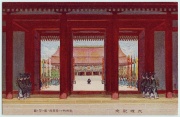Difference between revisions of "Relief halftone"
Jump to navigation
Jump to search
m (Text replace - "== Authority ==" to "== Sources Checked for Data in Record ==") |
m (Text replace - "\[http:\/\/cameo\.mfa\.org\/materials\/fullrecord\.asp\?name=([^\s]+)\s(.*)\]" to "$2") |
||
| Line 2: | Line 2: | ||
== Description == | == Description == | ||
| − | A reproductive process primarily used for photographs from the 1880s to the 1950s. A relief halftone block is prepared by printing a screened negative face down on a copperplate coated with [ | + | A reproductive process primarily used for photographs from the 1880s to the 1950s. A relief halftone block is prepared by printing a screened negative face down on a copperplate coated with [[fish%20glue|fish glue]]. The unexposed areas remain soluble after development and are washed away, then the plate is acid etched. |
== Synonyms and Related Terms == | == Synonyms and Related Terms == | ||
Revision as of 10:52, 10 May 2016
Description
A reproductive process primarily used for photographs from the 1880s to the 1950s. A relief halftone block is prepared by printing a screened negative face down on a copperplate coated with Fish glue. The unexposed areas remain soluble after development and are washed away, then the plate is acid etched.
Synonyms and Related Terms
color relief halftone; block process
Additional Images
Sources Checked for Data in Record
- Luis Nadeau, Encyclopedia of Printing, Photographic, and Photomechanical Processes, Atelier, New Brunswick, 1997
- B. Gascoigne, How to Identify Prints, Thames & Hudson, London, 2004


